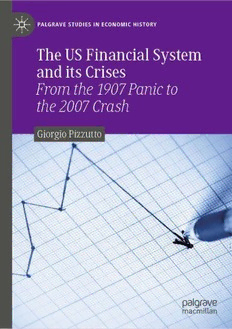
The US Financial System and its Crises : From the 1907 Panic to the 2007 Crash PDF
Preview The US Financial System and its Crises : From the 1907 Panic to the 2007 Crash
Palgrave Studies in Economic History Series Editor Kent Deng London School of Economics London, UK Palgrave Studies in Economic History is designed to illuminate and enrich our understanding of economies and economic phenomena of the past. The series covers a vast range of topics including financial his- tory, labour history, development economics, commercialisation, urban- isation, industrialisation, modernisation, globalisation, and changes in world economic orders. More information about this series at http://www.palgrave.com/gp/series/14632 Giorgio Pizzutto The US Financial System and its Crises From the 1907 Panic to the 2007 Crash Giorgio Pizzutto University of Milan Milan, Italy Palgrave Studies in Economic History ISBN 978-3-030-14488-3 ISBN 978-3-030-14489-0 (eBook) https://doi.org/10.1007/978-3-030-14489-0 Library of Congress Control Number: 2019933325 © The Editor(s) (if applicable) and The Author(s), under exclusive licence to Springer International Publishing AG, part of Springer Nature 2019 This work is subject to copyright. All rights are solely and exclusively licensed by the Publisher, whether the whole or part of the material is concerned, specifically the rights of translation, reprinting, reuse of illustrations, recitation, broadcasting, reproduction on microfilms or in any other physical way, and transmission or information storage and retrieval, electronic adaptation, computer software, or by similar or dissimilar methodology now known or hereafter developed. The use of general descriptive names, registered names, trademarks, service marks, etc. in this publication does not imply, even in the absence of a specific statement, that such names are exempt from the relevant protective laws and regulations and therefore free for general use. The publisher, the authors and the editors are safe to assume that the advice and information in this book are believed to be true and accurate at the date of publication. Neither the publisher nor the authors or the editors give a warranty, express or implied, with respect to the material contained herein or for any errors or omissions that may have been made. The publisher remains neutral with regard to jurisdictional claims in published maps and institutional affiliations. Cover illustration: Roman Sigaev/Alamy Stock Photo This Palgrave Macmillan imprint is published by the registered company Springer Nature Switzerland AG The registered company address is: Gewerbestrasse 11, 6330 Cham, Switzerland Contents 1 Introduction 1 2 The US Financial System from the National Banking Act to the Panic of 1907 7 3 The Birth of the Federal Reserve and Its Monetary Policy 33 4 Non-bank Financial Intermediaries and the Crisis of 1929 57 5 The Great Depression 75 6 The Money Market After World War II: Securitization and the Role of Dealers 103 7 Monetary Policy, Spread Compression, and the Housing Market 135 v vi Contents 8 The Money Market, the Collateral Market, and the Crisis of 2007–2008 173 9 Conclusions 199 Index 217 List of Figures Fig. 4.1 US short term interest rates 1925–1930 69 Fig. 6.1 Representation of the repo market 109 Fig. 6.2 Securitization 122 Fig. 6.3 CDO securitization 123 Fig. 6.4 Dealers repo 129 Fig. 6.5 Dealers reverse repo 130 Fig. 6.6 Repo relation between hedge fund and dealer 132 Fig. 7.1 Subprime profitability 142 Fig. 8.1 Mortgage securitization and market flows 176 Fig. 8.2 Spread ABCP/treasury 3 months 179 Fig. 8.3 Dealer intermediation 187 Fig. 8.4 Securities in–securities out 188 vii List of Tables Table 5.1 US bank assets (1926–1934) (millions of dollars) 82 Table 5.2 A ll member banks loan on securities, except to banks 1928–1933 (millions of dollars) 83 Table 5.3 B rokers’ loans by and through reporting member banks in New York City (Table 18, p. 1020, Appendix VII - millions of dollars) 83 Table 5.4 T otal brokers’ loans (Table 20, p. 1021, Appendix VII - millions of dollars) 84 Table 5.5 Brokers borrowing 1926–1929 (millions of dollars) 85 Table 5.6 A ll member banks: investments 1928–1934 (millions of dollars) 88 Table 5.7 A verage prices of bonds listed on the New York Stock Exchange, 1930–1932 (indexed to the year 1929 100) 89 = Table 5.8 US capital issues 1927–1932 (millions of dollars) 96 Table 7.1 CDO global issuance (billions of dollars) 143 Table 7.2 G lobal CDO issuance by underlying collateral (billions of dollars) 143 Table 7.3 M ortgage originations by product: 2001–2007 and share of originations (billions of dollars, percent) 146 Table 7.4 R esidential mortgage deals in 420 ABS CDOs. Number of deals by vintage and mortgage loan type 146 ix x List of Tables Table 7.5 CDO Issues (billions of dollars) 148 Table 7.6 T otal housing inventory for the USA (2000–2010 - millions) 152 Table 7.7 M ortgage related losses to US Investment Banks (June 2008 - billions of dollars) 157 Table 7.8 D ealers borrowing (Term securities lending facility and primary dealers lending facility - millions of dollars) 157 Table 7.9 C onditional forecast of losses on subprime investments from Lehman Brothers 158 Table 7.10 US homeownership rate (percent) 160 Table 7.11 Vacation and investment property sales (percentage) 164 Table 8.1 FHLB advances 2007 ($ billions) 183 Table 8.2 D ealers collateral source 2007 and 2010 (hedge fund and securities lending) 189 Table 8.3 S ecurities received from dealers as collateral with the permission to repledge and the collateral pledged to counterparties 190 Table 8.4 C ustodian by asset under custody (December 2010 - trillions of dollars) 191
